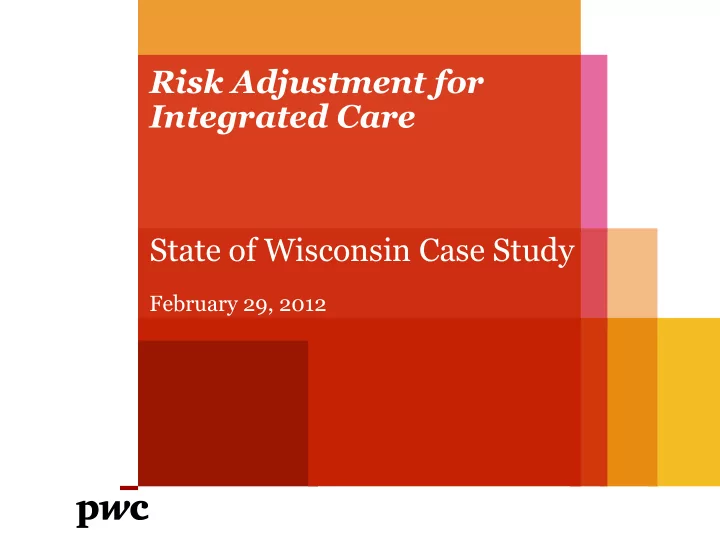

Risk Adjustment for Integrated Care State of Wisconsin Case Study February 29, 2012
Agenda Background Risk Adjustment Functional Screens Key Considerations PwC 2
State of Wisconsin Background • In the mid- 1990s, a broad consensus developed on the need to redesign Wisconsin’s long-term care system, prompted by concerns with its cost and complexity, inequities in availability, and projections of an aging population’s growing demand for long - term care services - PACE (Acute and Long Term Care, @1,000 enrollees) ◦ Initiated in Milwaukee county in 1990 and has since expanded to one additional county ◦ Legacy program - Family Care Partnership (Acute and Long Term Care; covers all ages , @4,000 enrollees): ◦ Similar to PACE, this program integrates health and long-term support services, and includes home and community-based services, physician services, and all medical care ◦ Began phase-in operations in the late 1990s to five pilot counties and beginning in 2007 coverage has expanded to 14 additional counties ◦ Initial sites were County Owned Organizations; now privately operated - Family Care (Long Term Care only @35,000 enrollees) ◦ Designed to provide cost-effective, comprehensive and flexible long-term care ◦ Initially piloted in five counties and is now nearly statewide PwC 3
State of Wisconsin Risk Adjustment • A unique risk assessment/risk adjustment model was needed to recognize variation in resource needs for the LTC population - The models use a combination of managed care claim, eligibility, and functional assessment data of enrollees in the Family Care program ◦ Commercial and other available models are largely designed to estimate the need for acute care services, and do not take into account such factors as frailty and the need for assistance with activities of daily living - Due to the material difference in cost and underlying functional needs, regression models are developed for three populations, individuals that are developmentally disabled, physically disabled, and frail elders ◦ The elements of the regression models vary based on the characteristics that are most prevalent to a population, with variation in both key variables and parameter values PwC 4
State of Wisconsin Risk Adjustment • The following chart provides the primary high cost drivers for each of the three target group populations Developmentally Disabled Physically Disabled Frail Elderly Ventilator Dependent Ventilator Dependent Ventilator Dependent Restrictive Measures Needs Assistance for 4-6 IADLs Had Tracheostomy Violent Behaviors to Others (High) Violent Behaviors to Others (Medium) Needs Assistance for 4-6 IADLs Prader Willi Syndrome HRS: Urinary Catheter HRS: Urinary Catheter Needs Assistance for 6 IADLs HRS: Positioning in Bed/Chair ADL: Bathing (High) Cannot Administer Medication ADL: Transferring (High) ADL: Toileting (High) ADL: Eating (High) HRS: Requires Nursing Interventions Violent Behaviors to Others (High) Self-Injurious Behaviors (High) ADL: Bathing (High) Mental Illness Need for Overnight Supervision Cannot Administer Medication Wound Cares Mental Health Needs Meets SNF Level of Care HRS: Requires Nursing Interventions PwC 5
State of Wisconsin Risk Adjustment • Long-Term Care Services - The models are developed using the experience of the first MCOs (termed Pilot Counties) and are used to develop the base rate for all areas ◦ Plans in Pilot Counties receive a relative risk score that is calculated to be revenue neutral across all plans in the pilot counties ◦ Plans in Expansion Counties receive an absolute risk score that is calculated based on the results of their functional screen data applied to the regression models • Acute & Primary Services - Acute care costs are adjusted using the Hierarchical Coexisting Condition (HCC) model to be consistent with Medicare Advantage risk adjustment PwC 6
State of Wisconsin Functional Screens • Wisconsin’s long -term care Functional Screen system was developed to provide an automated and objective way to determine the long-term care needs of elders and people with physical or development disabilities • Experienced professionals, usually social workers or registered nurses, who have taken an on-line training course and passed a certification exam are able to access and administer the screen • The functional screen is also used for: - Research - Establishing level of care for Family Care eligibility - Providing information helpful to people making decisions about how to meet their long-term care needs • Administered upon entry to the program, when there is an observed change in need, and on an annual basis PwC 7
State of Wisconsin Functional Screens • Wisconsin’s Functional Screen system collects the following information for the frail elderly and people with disabilities: - Demographic information - Type of living situation - The level of assistance for each instrumental activity of daily living (i.e. IADLs) - The level of assistance for each activity of daily living (i.e. ADLs) - The levels of communication, memory, and cognition - The extent of certain behaviors (wandering, self-injurious, offensive, etc.) - The use of medications and the level of assistance required to administer them - The presence of mental illness - The frequency of health related services (pain management, TPN, dialysis, etc.) - Diagnoses PwC 8
State of Wisconsin Key Considerations • The regression models and their application have continued to evolve over the past several years as the programs have grown. The models were refined to recognize: - Changes in the population mix enrolled in the program, particularly as very high cost cohorts such as MRDD were added - Transition from FFS to managed care experience in expansion regions, including consideration of: ◦ The magnitude and speed of expected savings ◦ Variation in potential risk status based on voluntary v. mandatory enrollment ◦ Health plan ability to take on the financial risk of the program PwC 9
State of Wisconsin References • Provided below are links to the program’s home page, the Functional Screen home page , and the capitation rate reports that include a more thorough description of the risk adjustment process - Family Care Home Page: http://www.dhs.wiscoin.gov/ltcare - PACE-FCP Home Page: http://www.dhs.wisconsin.gov/wipartnership/ - WI Functional Screen: http://www.dhs.wisconsin.gov/ltcare/FunctionalScreen/INDEX.HTM - Family Care Rate Report: http://www.dhs.wisconsin.gov/ltcare/statefedreqs/ratereport2012fc.pdf - PACE-FCP Rate Report: http://www.dhs.wisconsin.gov/ltcare/statefedreqs/ratereport2012fcp.pdf PwC 10
Questions PwC 11
Recommend
More recommend